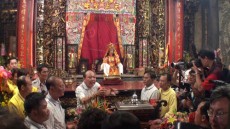TELDAP Collections
| Procession of Baishatun Matsu Pilgrimage ─Sedan Chair Mounting and Departure |

~~ Mountainside Matsu ~~
As there is no specific route for the Baishatun Matsu Pilgrimage, when the parade stops at a temple, a factory, a shop, or a household, believers believe that it is Baishatun Matsu who brings blessings to or eliminates disasters from this place. When the sedan chair stops at road sections or locations with frequent accidents, believers believe that Matsu is “handling things”, such as an exorcism or the eviction of demons and the salvation of the grievous souls (Lu, 2007:66). This way, Baishatun Matsu brings peace to the public. Walking throughout the procession is another feature of the Baishatun Matsu Pilgrimage. It is an old tradition and becomes a significance of the pilgrimage. As life was difficult in earlier times, believers must walk throughout the procession. Although people can use vehicles now, attendees still insist on walking to express their faithfulness for Matsu. Particularly, as the Baishatun Matsu Pilgrimage has no specific route, believers must follow the parade all along. This makes attendees firmly believe that walking with the parade throughout the pilgrimage allows them to feel Matsu’s will and intensify their faith in Matsu.
|












